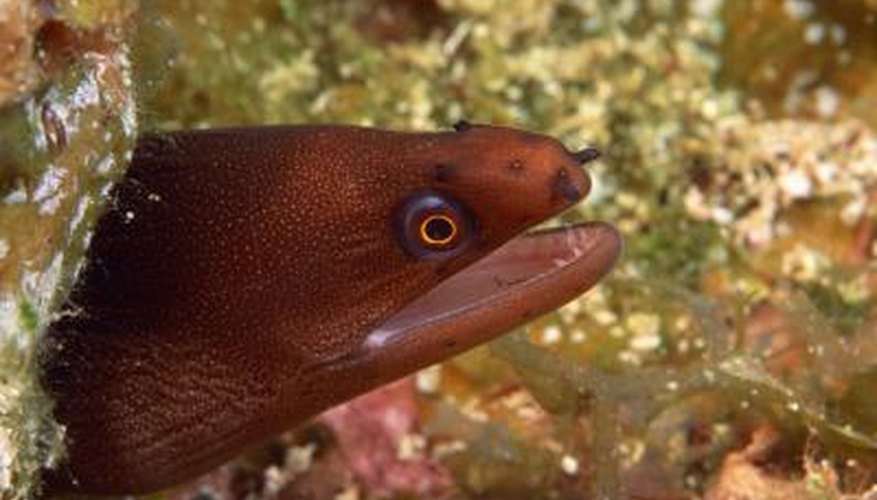Many creatures commonly called eels are not actually eels. These include electric eels, which are fish; rubber eels, which are amphibians; and spiny eels, slimy eels, swamp eels and eel catfish. Only members of the order Anguilliformes are true eels. These include freshwater eels, worm and spaghetti eels. Eels are generally predators and carnivores, and sometimes they're cannibals.
General Diet
Eels generally won't bother fish of a similar size, but do actively hunt smaller fish. Eels also eat invertebrates, crustaceans, shrimp, crabs and sea urchins. Eels kept in captivity may consume meat items such as beef hearts. Most eels don't eat other eels, but some will.
Some eels move back and forth between fresh water and ocean environments. In these varying environments, eels may select from a wider range of food items, including mosquito larvae and worms. While eels prefer to eat live prey, spiny and freshwater eels will eat carrion and will accept frozen bloodworms and tubifex worms as food.
- Eels generally won't bother fish of a similar size, but do actively hunt smaller fish.
- While eels prefer to eat live prey, spiny and freshwater eels will eat carrion and will accept frozen bloodworms and tubifex worms as food.
Diet by Type
Striped peacock eels consume crickets, fish, crustaceans, brine shrimp and plankton, earthworms, mealworms, blood worms, glass worms and tubifex worms. Short finned eels will eat frogs, mollusks, insects, fish and shrimp. Dragon eels consume fish, but also eat squid and octopus. Garden eels eat meat, live shrimp and feeder fish. Moray eels eat fish, mollusks and other eels. They hunt through smell and hide and ambush their prey. Juvenile electric eels eat invertebrates such as shrimp and crabs, while adults eat fish, crustaceans and amphibians.
- Striped peacock eels consume crickets, fish, crustaceans, brine shrimp and plankton, earthworms, mealworms, blood worms, glass worms and tubifex worms.
- Juvenile electric eels eat invertebrates such as shrimp and crabs, while adults eat fish, crustaceans and amphibians.
Teeth and Diet
Snowflake eels have blunt teeth made to grind prey with shells, such as mollusks, crabs and shrimp. Moray eels have sharp, pointed teeth made for catching and holding live prey. They eat crustaceans, invertebrates, small fish and smaller eels. In captivity, they may eat fresh or frozen squid, crustaceans, feeder fish or other meats. Moray eels have been observed by researchers cooperatively hunting for food with grouper fish.
- Snowflake eels have blunt teeth made to grind prey with shells, such as mollusks, crabs and shrimp.
- Moray eels have sharp, pointed teeth made for catching and holding live prey.
The gulper eel, also called the pelican eel or umbrella mouth gulper, eats fish, seaweed, small crustaceans and invertebrates, shrimp and plankton, octopus and squid. These eels eat by scooping up prey in their large, open mouths. Because they have very small teeth, these eels generally feed on smaller prey, but they can consume larger creatures.
Commercial Diet
Commercially produced foods for eels raised in tanks or ponds include high protein pellets and pastes. These may contain ingredients such as beef livers, tubifex worms and fish meal. Eel feed may also contain ingredients such as binders, wheat, starch, soybean meal, corn, vegetable or animal fat, minerals and vitamins. Tubifex worms, chopped clam and fish meal are used as a starter diet for elvers, or young eels.
- Commercially produced foods for eels raised in tanks or ponds include high protein pellets and pastes.
- Tubifex worms, chopped clam and fish meal are used as a starter diet for elvers, or young eels.
People continue to experiment with locally available ingredients to reduce the cost of feeding eels without compromising eel health and condition. Some of the foods tried include sheeps' livers and spleens, fish canning by-products, carp viscera and livers and trash fish, minus their heads and gills. Usually producers remove the connective tissues and hard parts of these meat and fish products so that they can be ground.
